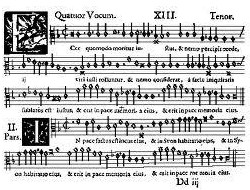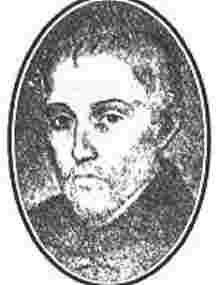|
Ecce Quo Modo Moritur Justus
The righteous perishes are the words with which the 57th chapter of the Book of Isaiah starts. In Christianity, Isaiah 57:1–2 is associated with the death of Christ, leading to liturgical use of the text at Tenebrae: the 24th responsory for Holy Week, "Ecce quomodo moritur justus" (See how the just dies), is based on this text. More generally, the text is associated with the death of loved ones and is used at burials. As such, and in other versions and translations, the Bible excerpt has been set to music. Text contain awkward shifts between singular and plural, contrasting a group whom the prophetic tradition approves and others who are strongly condemned. : ''The righteous perishes,'' : ''And no man takes it to heart;'' : ''Merciful men are taken away,'' : ''While no one considers'' : ''That the righteous is taken away from evil.'' : ''He shall enter into peace;'' : ''They shall rest in their beds,'' : ''Each one walking in his uprightness.'' *"The righteous" (KJV, NASB, ... [...More Info...] [...Related Items...] OR: [Wikipedia] [Google] [Baidu] |
Psalm 64
Psalm 64 is the 64th psalm of the Book of Psalms, beginning in English in the King James Version: "Hear my voice, O God, in my prayer: preserve my life from fear of the enemy". In the slightly different numbering system of the Greek Septuagint version of the Bible and the Latin Vulgate, this psalm is Psalm 63. In Latin, it is known as "Exaudi Deus orationem meam". It is directed against the "wicked" (רעע) and "workers of iniquity" (פֹּעֲלֵי אָֽוֶן), whom God shall shoot with an arrow (וַיֹּרֵם אֱלֹהִים חֵץ). The psalm may be treated as a prayer for deliverance from enemies, or as a thanksgiving, or a testimony to divine judgement. The psalm forms a regular part of Jewish, Catholic, Lutheran, Anglican and other Protestant liturgies. It has been set to music. Text Hebrew Bible version The following is the Hebrew text of Psalm 64: King James Version # Hear my voice, O God, in my prayer: preserve my life from fear of the enemy. # Hide ... [...More Info...] [...Related Items...] OR: [Wikipedia] [Google] [Baidu] |
Giovanni Pierluigi Da Palestrina
Giovanni Pierluigi da Palestrina ( – 2 February 1594) was an Italian composer of late Renaissance music. The central representative of the Roman School, with Orlande de Lassus and Tomás Luis de Victoria, Palestrina is considered the leading composer of late 16th-century Europe. Primarily known for his masses and motets, which number over 105 and 250 respectively, Palestrina had a long-lasting influence on the development of church and secular music in Europe, especially on the development of counterpoint. According to '' Grove Music Online'', Palestrina's "success in reconciling the functional and aesthetic aims of Catholic church music in the post-Tridentine period earned him an enduring reputation as the ideal Catholic composer, as well as giving his style (or, more precisely, later generations’ selective view of it) an iconic stature as a model of perfect achievement." Biography Palestrina was born in the town of Palestrina, near Rome, then part of the Papal States to N ... [...More Info...] [...Related Items...] OR: [Wikipedia] [Google] [Baidu] |
Marc'Antonio Ingegneri
Marc'Antonio Ingegneri (also spelled Ingegnieri, Ingignieri, Ingignero, Inzegneri) (c. 1535 or 1536 – 1 July 1592) was an Italian composer of the late Renaissance. He was born in Verona and died in Cremona. Even though he spent most of his life working in northern Italy, because of his stylistic similarity to Palestrina he is often considered to be a member of the Roman School of polyphonic church music. He is also famous as the teacher of Claudio Monteverdi. Not much is known about his early life, but he probably had family from Venice, and he likely studied with Cipriano de Rore at Parma, and Vincenzo Ruffo at Verona. Sometime around 1570 he moved to Cremona, and established a reputation there as a composer and instrumentalist. He may have been an organist, and is known to have been a string player. In 1581 he became ''maestro di cappella'' of the cathedral there, and he apparently remained in this position for the rest of his life. While at this position he is known to have tau ... [...More Info...] [...Related Items...] OR: [Wikipedia] [Google] [Baidu] |
Motet
In Western classical music, a motet is mainly a vocal musical composition, of highly diverse form and style, from high medieval music to the present. The motet was one of the pre-eminent polyphonic forms of Renaissance music. According to Margaret Bent, "a piece of music in several parts with words" is as precise a definition of the motet as will serve from the 13th to the late 16th century and beyond.Margaret Bent,The Late-Medieval Motet in ''Companion to Medieval & Renaissance Music'', edited by Tess Knighton and David Fallows, 114–19 (Berkeley, California: University of California Press, 1992): 114. . The late 13th-century theorist Johannes de Grocheo believed that the motet was "not to be celebrated in the presence of common people, because they do not notice its subtlety, nor are they delighted in hearing it, but in the presence of the educated and of those who are seeking out subtleties in the arts". Etymology In the early 20th century, it was generally believed the name ... [...More Info...] [...Related Items...] OR: [Wikipedia] [Google] [Baidu] |
Franz Liszt
Franz Liszt, in modern usage ''Liszt Ferenc'' . Liszt's Hungarian passport spelled his given name as "Ferencz". An orthographic reform of the Hungarian language in 1922 (which was 36 years after Liszt's death) changed the letter "cz" to simply "c" in all words except surnames; this has led to Liszt's given name being rendered in modern Hungarian usage as "Ferenc". From 1859 to 1867 he was officially Franz Ritter von Liszt; he was created a ''Ritter'' (knight) by Emperor Franz Joseph I of Austria, Francis Joseph I in 1859, but never used this title of nobility in public. The title was necessary to marry the Princess Carolyne zu Sayn-Wittgenstein without her losing her privileges, but after the marriage fell through, Liszt transferred the title to his uncle Eduard in 1867. Eduard's son was Franz von Liszt., group=n (22 October 1811 – 31 July 1886) was a Hungarian composer, pianist and teacher of the Romantic music, Romantic period. With a diverse List of compositions by Franz L ... [...More Info...] [...Related Items...] OR: [Wikipedia] [Google] [Baidu] |
Jan Dismas Zelenka
Jan Dismas Zelenka (16 October 1679 – 23 December 1745), baptised Jan Lukáš Zelenka was a Czech composer and musician of the Baroque period. His music is admired for its harmonic inventiveness and mastery of counterpoint. Zelenka was raised in Central Bohemia, educated in Prague and Vienna, and spent his professional life in Dresden. The greatest success during his career was the performance of the extensive composition ''Sub olea pacis et palma virtutis'' in the presence of the Emperor Charles VI, shortly after his coronation as king of Bohemia in 1723. Life Early life Zelenka was born in Louňovice pod Blaníkem, a market town southeast of Prague, in Bohemia. He was the eldest of eight children born to Marie Magdalena (née Hájek) and Jiří Zelenka. The middle name Dismas is probably his confirmation name. Zelenka's father Jiří was a schoolmaster and organist in Louňovice, and was likely his first music teacher. Nothing more is known with certainty about Zelen ... [...More Info...] [...Related Items...] OR: [Wikipedia] [Google] [Baidu] |
Responsoria Et Alia Ad Officium Hebdomadae Sanctae Spectantia
''Responsoria et alia ad Officium Hebdomadae Sanctae spectantia'' is a collection of music for Holy Week by Italian composer Carlo Gesualdo, published in 1611. It consists of three sets of nine short pieces, one set for each of Maundy Thursday, Good Friday and Holy Saturday, and a psalm and a hymn. The work was written for unaccompanied voices: two soprano parts, alto, two tenor parts, and bass. The texts of the Responsories for Holy Week are related to Jesus's Passion and are sung in between the lessons at Tenebrae. Gesualdo's settings are stylistically ''madrigali spirituali'' - madrigals on sacred texts. As in Gesualdo's later books of madrigals, he uses particularly sharp dissonance and shocking chromatic juxtapositions, especially in the parts highlighting text passages having to do with Christ's suffering, or the guilt of St. Peter in having betrayed Jesus. Content #Tenebrae Responsories for Maundy Thursday ##In monte Oliveti ##Tristis est anima mea ##: Alex Ross write ... [...More Info...] [...Related Items...] OR: [Wikipedia] [Google] [Baidu] |
Carlo Gesualdo
Carlo Gesualdo da Venosa ( – 8 September 1613) was Prince of Venosa and Count of Conza. As a composer he is known for writing madrigals and pieces of sacred music that use a chromatic language not heard again until the late 19th century. He is also known for killing his first wife and her aristocratic lover upon finding them ''in flagrante delicto''. Biography Early life Gesualdo's family had acquired the principality of Venosa in what is now the Province of Potenza, Southern Italy, in 1560. He was probably born on March 30, 1566, three years after his older brother Luigi, though some sources have stated that he was born on March 8. Older ones give the year of birth as 1560 or 1561, but this is no longer accepted. A letter from Gesualdo's mother, Geronima Borromeo, indicates that the year is most likely 1566. Gesualdo's uncle was Carlo Borromeo, later Saint Charles Borromeo. His mother was the niece of Pope Pius IV. Most likely Carlo was born at Venosa, then par ... [...More Info...] [...Related Items...] OR: [Wikipedia] [Google] [Baidu] |
Officium Hebdomadae Sanctae
Holy Week ( la, Hebdomada Sancta or , ; grc, Ἁγία καὶ Μεγάλη Ἑβδομάς, translit=Hagia kai Megale Hebdomas, lit=Holy and Great Week) is the most sacred week in the liturgical year in Christianity. In Eastern Churches, which includes Eastern Orthodox, Eastern Catholic and Eastern Lutheran traditions, Holy Week occurs the week after Lazarus Saturday and starts on the evening of Palm Sunday. In the denominations of the Western Christianity, which includes the Roman Catholicism, Lutheranism, Moravianism, Anglicanism, Methodism and Reformed Christianity, it begins with Palm Sunday and concludes on Easter Sunday. For all Christian traditions it is a moveable observance. In Eastern Rite Churches, Holy Week starts after 40 days of Lent and two transitional days, namely Saturday of Lazarus (Lazarus Saturday) and Palm Sunday. In the Western Christian Churches, Holy Week falls on the last week of Lent or Sixth Lent Week. Holy Week begins with the commemoration of C ... [...More Info...] [...Related Items...] OR: [Wikipedia] [Google] [Baidu] |
Tomás Luis De Victoria
Tomás Luis de Victoria (sometimes Italianised as ''da Vittoria''; ) was the most famous Spanish composer of the Renaissance. He stands with Giovanni Pierluigi da Palestrina and Orlande de Lassus as among the principal composers of the late Renaissance, and was "admired above all for the intensity of some of his motets and of his Offices for the Dead and for Holy Week". His surviving ''oeuvre'', unlike that of his colleagues, is almost exclusively sacred and polyphonic vocal music, set to Latin texts. As a Catholic priest, as well as an accomplished organist and singer, his career spanned both Spain and Italy. However, he preferred the life of a composer to that of a performer. Life and career Victoria was born in Sanchidrián in the province of Ávila, Castile, around 1548 and died in 1611. Victoria's family can be traced back for generations. Not only are the names of the members in his immediate family known, but even the occupation of his grandfather. Victoria was the sev ... [...More Info...] [...Related Items...] OR: [Wikipedia] [Google] [Baidu] |






